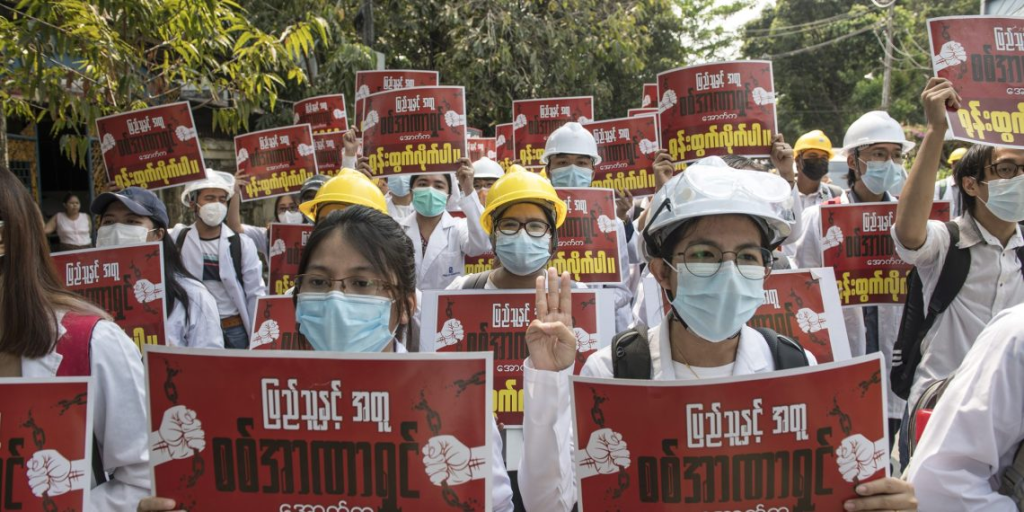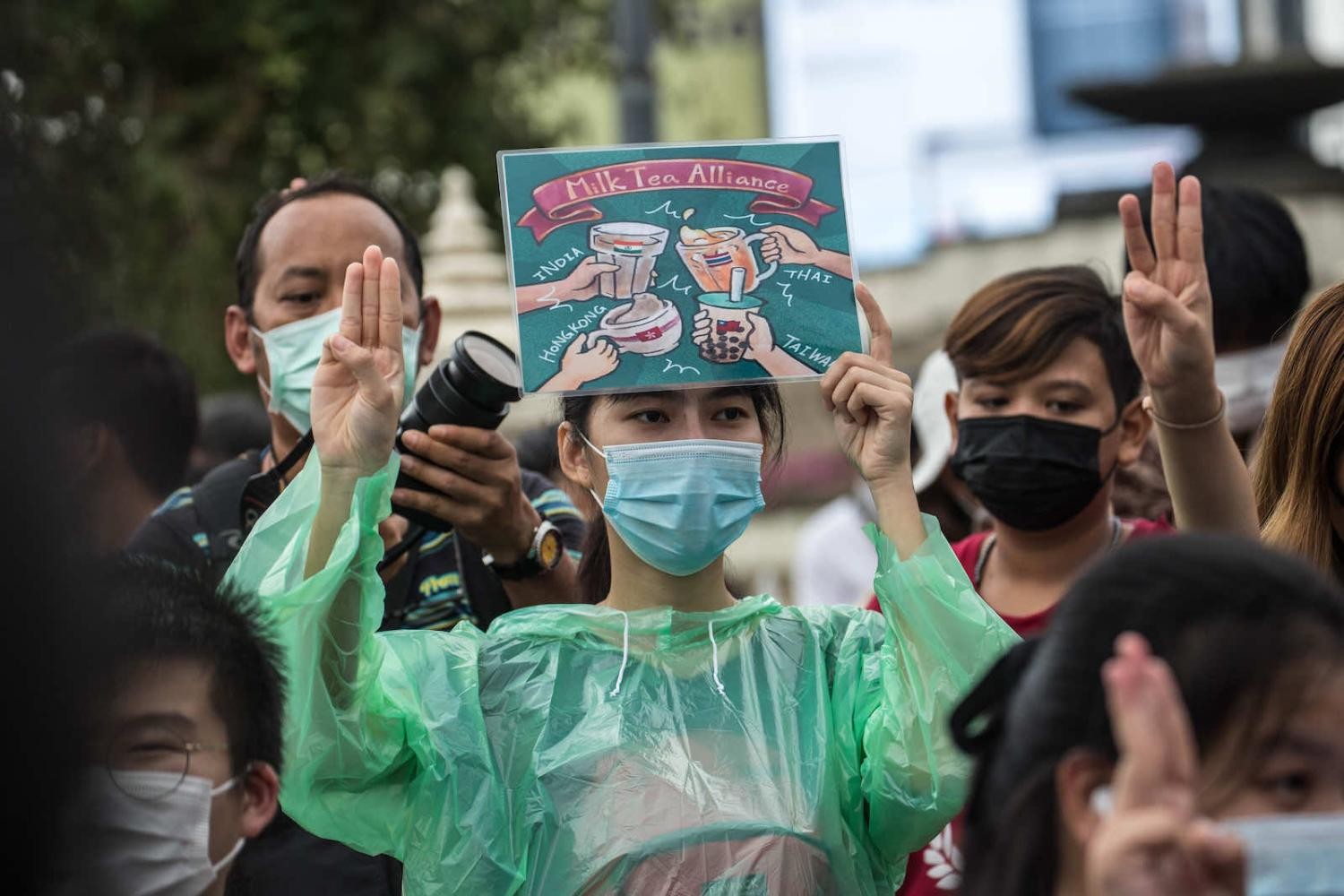Figure 1. A protester in Bangkok in October (2022), the sign featuring causes spanning Thailand, Taiwan, Hong Kong, and India (Geem Drake via Getty Images)
The Asia-Pacific (APAC) region is home to over 60% of the world’s youth population, positioning youth as key drivers of social and political change [1]. However, the state of youth civic participation in APAC varies widely across a spectrum. In more democratic countries like South Korea, Taiwan, Australia, and New Zealand, youth councils and leadership programs provide platforms for policy advocacy. In contrast, in countries like China, Vietnam, and Myanmar, young activists face censorship, surveillance, and repression. Yet, even in restrictive environments, youth continue to push boundaries, leveraging digital platforms and grassroots networks to advocate for change.
Across the APAC region, youth-led movements are driving change. In Thailand, the Free Youth Movement has led protests demanding constitutional reforms [2][3]. In Myanmar, young people played a crucial role in the Civil Disobedience Movement (CDM) to resist the military coup [4]. In Australia and the Pacific Islands, youth are at the forefront of climate action through movements like School Strike for Climate [5]. In Indonesia and the Philippines, groups such as Jaga Rimba and Kalikasan Youth Network fight environmental degradation and corruption. Meanwhile, in South Korea, young voters influence elections by advocating for economic and social reforms [6]. These movements underscore youth resilience and influence, even in the face of government resistance.

Figure 2. Medics and medical students held placards during an anti-regime protest in Naypyitaw in February 2021. / The Irrawaddy
Technology has transformed youth civic engagement, but presents both opportunities and challenges. Social media platforms like X and Facebook have facilitated protests and activism, but some governments use surveillance and censorship to suppress dissent. Platforms like Facebook and TikTok amplify global information sharing, but misinformation distorts narratives and can mislead activists. Online spaces connect activists across borders, fostering global solidarity. Yet the digital divide excludes rural and marginalized youth. Additionally, while online campaigns shape policies, algorithms can suppress political content, reducing its reach.
Education plays a critical role in equipping youth with the knowledge and skills needed for civic engagement. Countries that integrate civic education into curricula help students understand governance, democracy, and activism. For example, in India, the National Youth Parliament provides hands-on political participation experiences. In Hong Kong, universities have historically been hubs of student activism [7]. However, in some APAC countries, discussions on democracy and human rights are restricted by government censorship. Civic education is often neglected, leaving many youth unaware of their rights. In authoritarian regimes, education is sometimes used to suppress dissent rather than encourage engagement [8].
Despite these challenges, opportunities exist to enhance youth participation in the civic space. Leveraging digital tools can help mobilise youth across borders. Government policies like the Philippines’ Sangguniang Kabataan (Youth Councils) offer structured participation in governance [9]. International organizations can also support youth-driven reforms and provide safe spaces for engagement. Through technology, education reforms, and supportive policies, youth can continue expanding their civic space.
As the youth population in APAC grows, their role in shaping the region’s future is undeniable. A thriving civic space is essential for sustainable and equitable development. Protecting the rights of youth to engage in civic and political life will is critical as it will determine the APAC region’s trajectory. It is imperative for governments and institutions to foster an environment where youth voices can be heard and valued.
If you found this article useful, please remember to ‘Like’ and share on social media, and hit the ‘Follow’ button never to miss an article.
About the authors: Daniel Lindgren is the Founder of Rapid Asia Co., Ltd., a management consultancy firm based in Bangkok specializing in evaluations for programs, projects, social marketing campaigns, and other social development initiatives. Viet Khue Do works at Rapid Asia as a project assistant intern.
References
- “30 for 2030,” UN Women Asia-Pacific, accessed April 8, 2025,
- Anusorn Unno, “Reform, Not Abolition: The Thai Youth Movement and Its Demands for Reform of the Monarchy,” ISEAS Perspective, no. 3 (2022),
- Kanokrat Lertchoosakul, “The Rise and Dynamics of the 2020 Youth Movement in Thailand,” Heinrich Böll Stiftung, February 2022,
- “Civil Disobedience Movement: A Foundation of Myanmar’s Spring Revolution and Force Behind Military’s Failed Coup,” Progressive Voice Myanmar, May 25, 2023,
- Rafqa Touma and Australian Associated Press, “School Strike 4 Climate: Australian Students Skip Classes en Masse to Call for Action,” The Guardian, November 17, 2023,
- Wenhong Chen and David K. Dimitrova, “Social Media as a Civic Mobilizer: Community Storytelling Network, Social Media, and Civic Engagement in the United States,” Journal of Broadcasting & Electronic Media 65, no. 2 (2021): 197–216,
- “Youth-Led Social Identity and Movements: A Case Study of Youth Activism in Hong Kong,” ResearchGate, September 2021,
- Thuy Nguyen, “Exploiting Ideology and Making Higher Education Serve Vietnam’s Authoritarian Regime,” Communist and Post-Communist Studies 55, no. 4 (2022): 83–104,
- “Empowering the Future: The Sangguniang Kabataan’s Role in Shaping the Lives of Young Filipinos,” Journal of Interdisciplinary Perspectives, accessed April 8, 2025,

